
Cooking with Cast Iron
Cast iron cookware is a versatile, dependable tool for creating both culinary and confectionary classics in restaurants. When properly maintained, the best cast iron cookware will last a lifetime, with a natural non-stick coating that rivals man-made options. It can be used with any heat source, including induction, ceramic, electric, and gas cooktops, as well as ovens, grills, or even campfires.
Shop All Cast Iron Cookware

How is Cast Iron Cookware Made?
1. Blocks of iron and steel are melted together in a factory in the perfect proportions.
2. Chemicals are added to the melted mixture to raise its carbon level. Cast iron normally contains 2 to 3 percent carbon to 97 to 98 percent iron. This is what differentiates it from carbon steel, which usually contains roughly 99 percent iron to 1 percent carbon.
3. The molten metal is poured into a mold made of sand, water, and powdered clay.
4. The sand mold is broken and the cookware is released once the cookware has cooled. Each piece of cookware is then smoothed by workers before being sold.
6. If the cast iron is pre-seasoned, a coating of wax or vegetable oil is applied at this point to prevent the cookware from rusting while it sits on store shelves or in the warehouse.

How To Season Cast Iron Cookware
1. Preheat your oven to 400 degrees Fahrenheit.
2. Coat cast iron with a thin layer of of vegetable shortening or lard on the interior and exterior of the cast iron pan. Coat all of the areas except the handle.
3. Place a lined baking sheet on the bottom rack of your oven to catch any shortening or lard that drips down.
4. Put your coated cast iron pan or skillet on the middle rack.
5. Leave the pan in the oven for 45 minutes to an hour.
6. Remove the pan, wipe it dry with a clean cloth, and let it cool completely.

Never put cold water in a hot or warm cast iron pan because it was cause the pan to warp or crack.
Cast iron should be properly seasoned prior to use. Seasoning cast iron cookware will allow you to cook with less oil, butter, or fat, and it gives your pans a non-stick surface while keeping them from rusting quickly. Plus, less fat means healthier cooking and lower expenses, benefiting both your customers and your bottom line. For more information on how to season cast iron, check out our Pan Seasoning Guide. This video also does a great job summarizing the best way to season cast iron cookware.
Cast Iron Troubleshooting
Even with the most meticulous maintenance, sometimes bad things happen to good cast iron. Here's how to handle these situations.
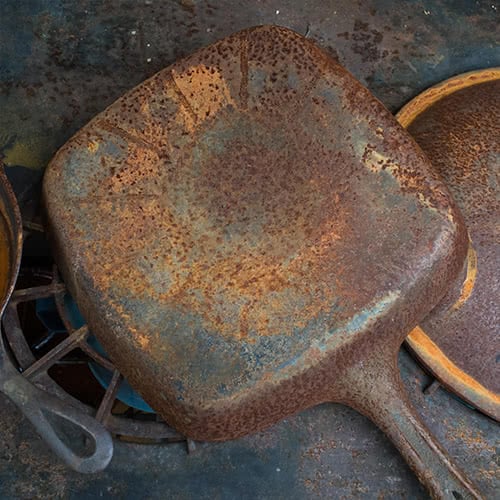
Rust
What is rust? A red-orange coating which forms on the surface of the pan.
Why did this happen? The pan was not properly cleaned, dried, or stored.
Is rust on cast iron dangerous? A little bit of rust on cookware isn't likely to harm you. Effectively cleaning and reseasoning the pan will restore it to a like-new condition, though.
How to remove rust from cast iron: If the entire pan is rusted, you'll need to re-season the whole piece. If only one or two spots is rusted, rinse the pan out with water, dry it thoroughly, heat it up, and rub it down with oil. The rusted spot should become well-seasoned again after a few uses.
How to prevent rust: Properly clean, dry, and store the pan each time you use it.
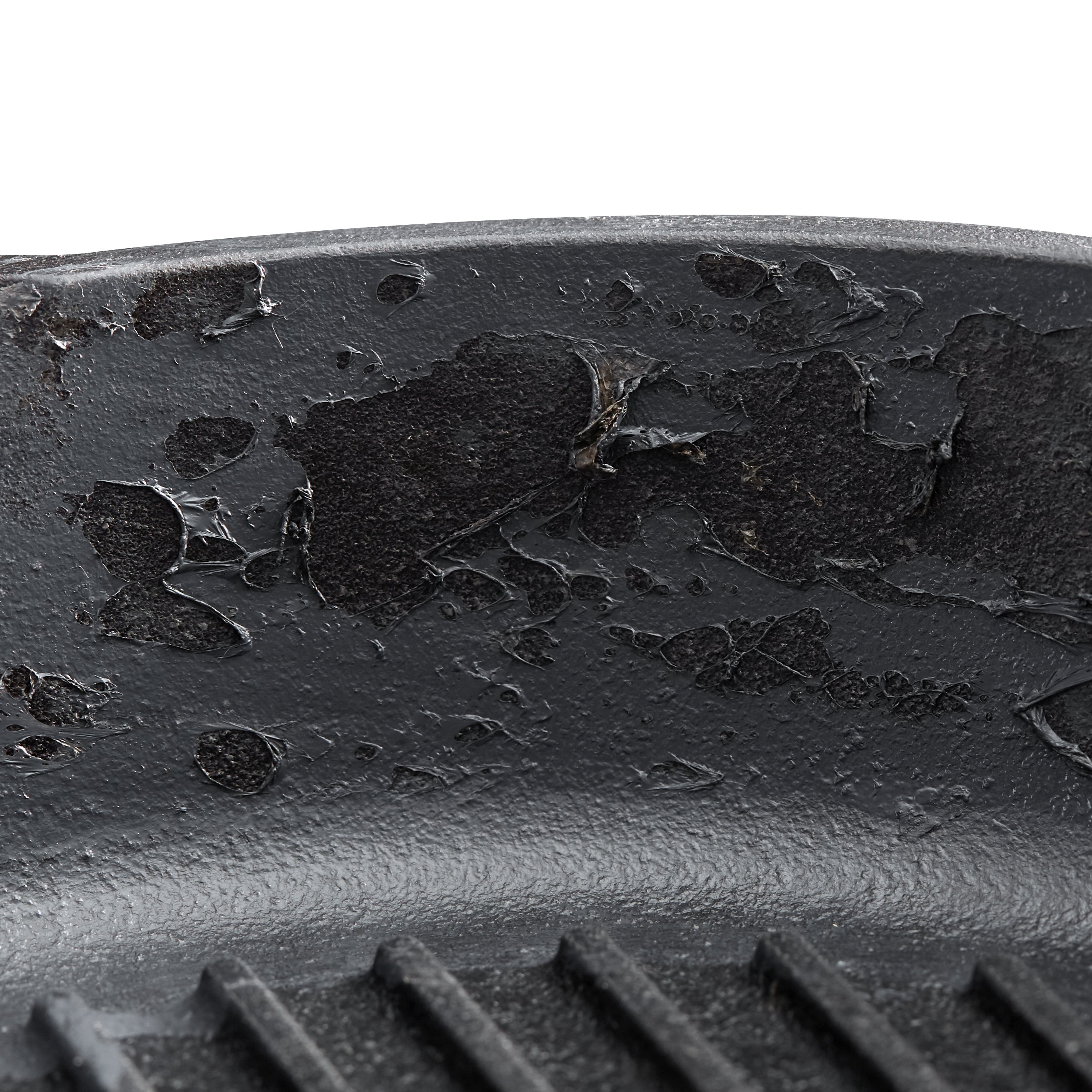
Scaling
What is scaling? The seasoning on the pan sloughs off in large flakes.
Why did this happen? You tend to heat the pan too often without adding extra oil to it.
How to remove scale: Once scaling starts, there's no going back. To remedy this problem, you'll need to re-season the pan from the start.
How to prevent scaling: Regularly oil the pan after each use. Do not overheat the pan.
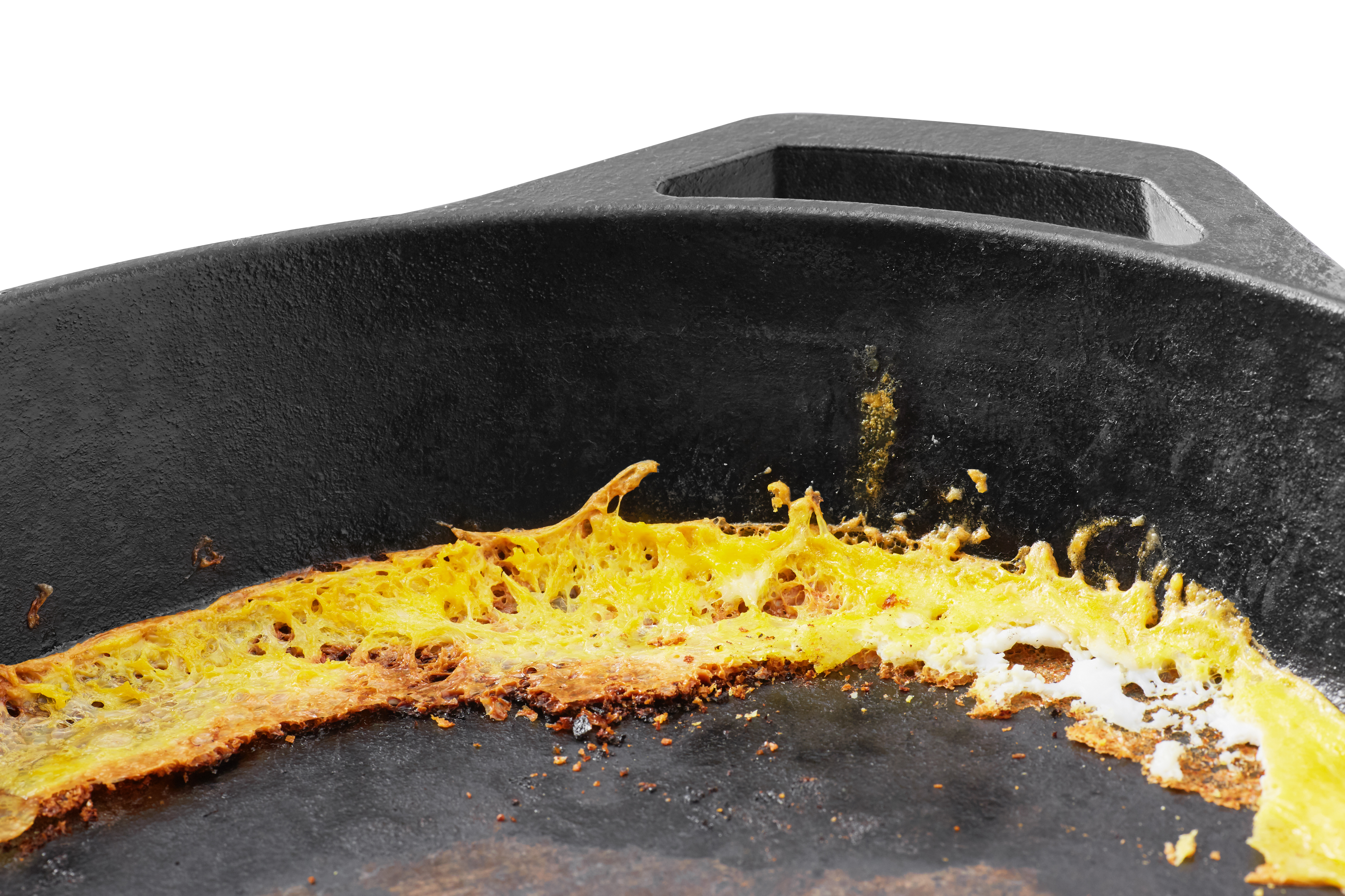
Food Sticking
What is it? Food starts sticking to the surface of the pan.
Why did this happen? The seasoning on the pan has worn off.
How to remove stuck-on food: Re-season the pan for a smooth, non-stick surface.
How to make cast iron non-stick: Regularly season the pan to maintain the non-stick surface.
Cast Iron vs. Non-Stick Aluminum Cookware
Properly-seasoned cast iron cookware often serves as an ideal alternative to non-stick aluminum cookware. However, it does have its limitations, too.
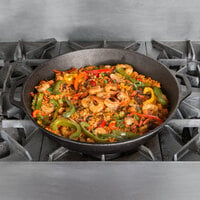

- Incredibly Durable: No joints or rivets; nearly indestructible
- Self-Created Non-Stick Surface: Safe if seasoning flakes off; allows you to cook with less oil than traditional cookware
- Versatile: Can use metal utensils on surface; use on electric, gas, induction, or open flame heat sources
- Maintains Temperature: Minimal temperature loss when food is added
- Heavy: Cast iron is a relatively heavy product by nature
- Shouldn't Cook Overly Acidic Foods in it: Will pick up flavor and color from the iron
- Requires Careful Maintenance: Keeping up with proper seasoning is essential to maintaining cast iron cookware
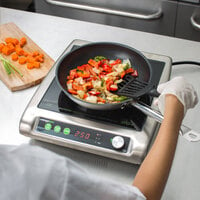

- Non-Stick Surface: Allows you to cook with less oil than traditional cookware
- Light Weight: Non-stick aluminum is a relatively light weight product
- Versatile: Can cook any type of food in it; use on electric or gas heat sources
- Requires Minimal Maintenance: Cleaning and maintaining non-stick aluminum cookware is quick and easy
- Welded Joints or Rivets May Wear Out: Constructed with a two-piece design, non-stick aluminum is susceptible to worn out joints or rivets
- Man-Made Non-Stick Surface: Potentially dangerous if flakes off
- Limiting: Should not use metal utensils on surface; limited lifespan
- Temperature Loss: Greater temperature loss when food is added
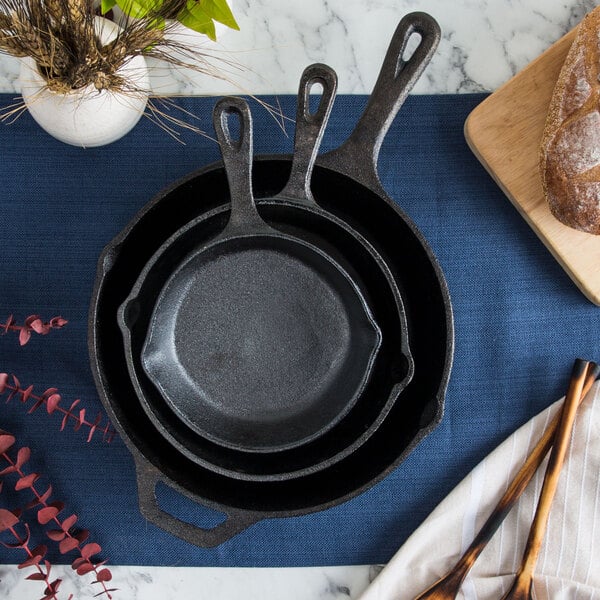
Cleaning Cast Iron Cookware
Cleaning cast iron is easy with the right tools for the job.
- To start, scrub any dried on food with a firm brush, water, and kosher salt (if extra abrasion is needed).
- Once clean, dry it with a paper towel and place it on the range or in the oven at low heat to fully remove any traces of water.
- When your pan is completely dry, reheat it, then wipe it down with a paper towel soaked in your seasoning oil before storing.
- Store your seasoned cookware in a cool, dry place to prevent rust. If stacked, place a towel or paper towel between pans.

Cast Iron Cleaning Tips
- Clean your cookware immediately after use.
- Never leave cast iron soak in the sink.
- Should a stubborn soil remain, use a bit of kosher salt in place of a tough abrasive.
What are Pre-Seasoned and Porcelain Enameled Cast Iron Cookware?
After cast iron cookware is made, it can be sold as-is, or it can be pre-seasoned or porcelain enameled for added benefits.

- Most economical form of cast iron
- Easy to season for a smooth release
- Must be seasoned right out of the box

- Offers a natural, easy-release finish that improves with use
- Pre-seasoned surface minimizes surface rusting
- Requires re-seasoning over time
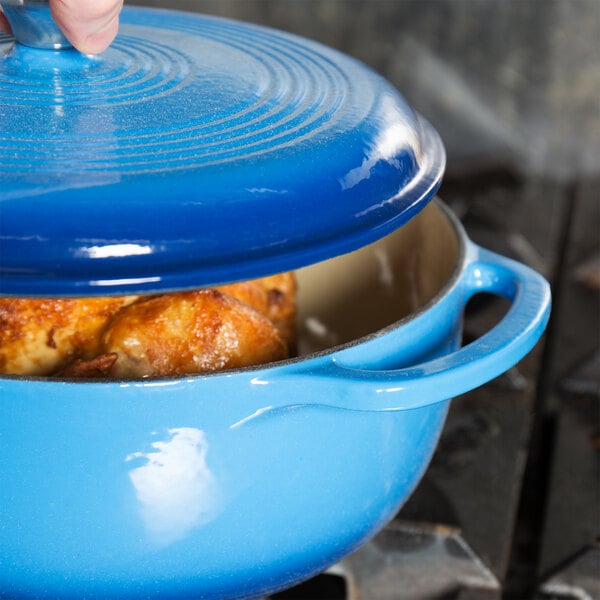
- Combines benefits of cast iron and beauty of porcelain enamel
- Ideal for display cooking applications
- Porcelain enamel susceptible to breakage
Types of Cast Iron Cookware
Cast iron cookware has hundreds of uses in commercial kitchens. From roasting meats to baking decadent desserts, each piece has its own purpose. Start on stovetop for a nice layer of caramelization from the high heat, then finish in the oven with radiant heat. No matter how you use it, cooking with cast iron is sure to give you an authentic finish.
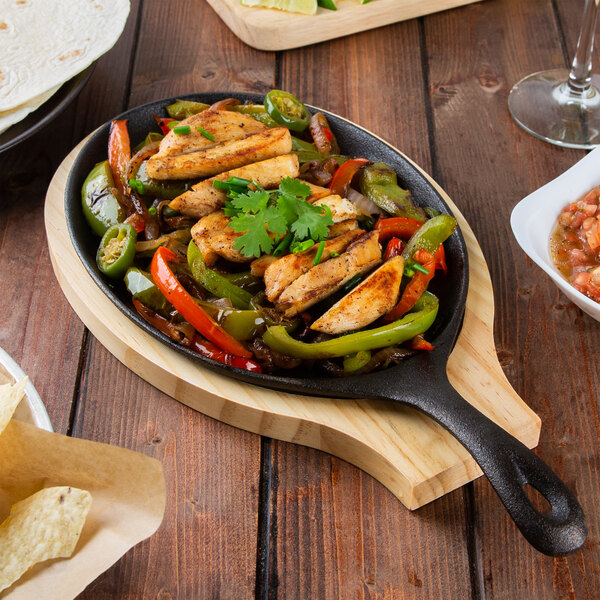
- Incredibly versatile
- One pan can serve many purposes in different contexts
- Easily goes from oven-to-table for efficient service

- Bakes appetizers, desserts, side dishes, and vegetables
- Miniature size is perfect for serving individual servings
- Incredible durability and dishwasher safe

- Bakes pasta, casseroles, pot pie, baked macaroni and cheese, and vegetables
- Two handles provide easy carrying and transport
- Use with or without a lid

- Can saute onions, melt butter, and sear steak, chicken, or fish
- Great for serving entrees; material keeps contents warm throughout the entire meal
- Available with smooth or grooved surface
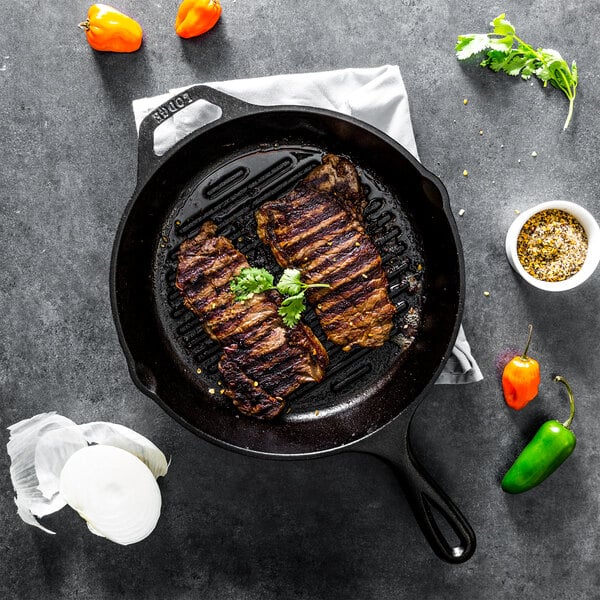
- Perfect for grilling steaks, chicken, salmon, or tuna
- Ridges allow grease to drain away from the food while creating tantalizing grill marks
- Helper handles make it easy to lift larger pans
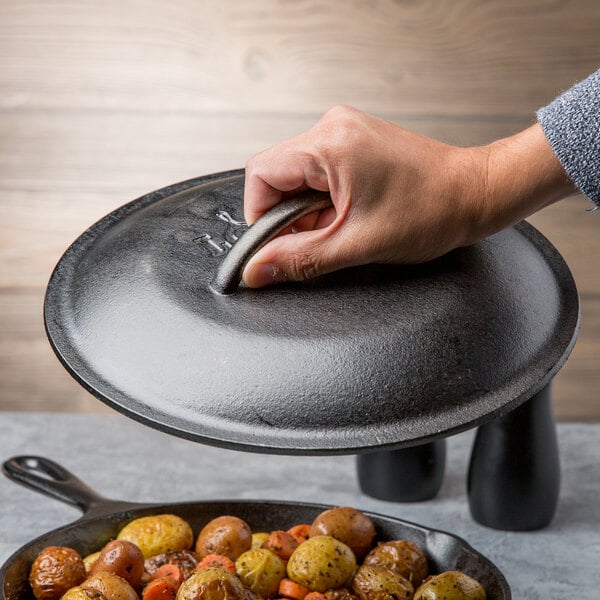
- Adds additional heat retention to your cast iron cookware
- Also helps maintain moisture
- Larger covers feature self-basting tips to continually baste food
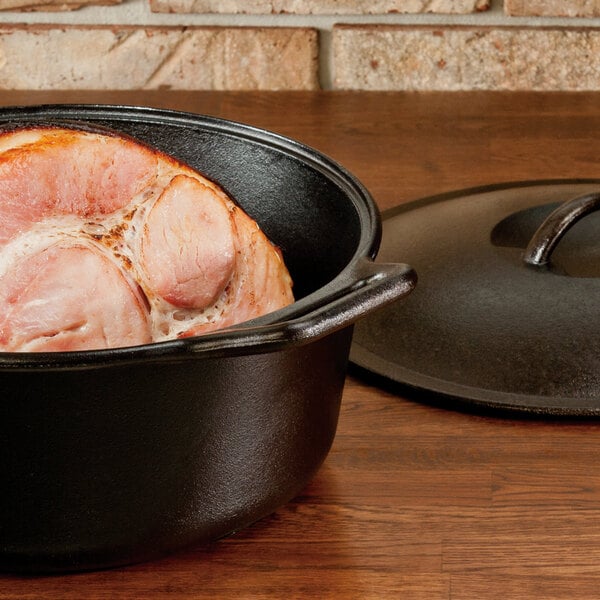
- Tight fitting lid ensures heat retention while locking in moisture
- Wide variety of sizes available to meet individual needs

- Perfect for making Korean barbecue, flat bread, grilled tortillas, or roasting vegetables
- Intended for placement over stove or range burners
- Designed with ridges to produce an appealing grilled texture
Frequently Asked Questions
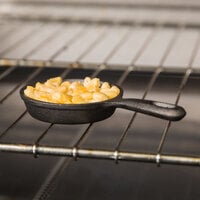
Can I Put Cast Iron In the Oven?
Cast iron can definitely go in the oven! We're not just talking Dutch ovens or other obvious bakeware pieces, either. Griddles, skillets, even pots can be used in the oven for added versatility! Pop them in the oven to:
- Preheat the piece (make sure you rotate it to evenly distribute the heat)
- Cook right in the oven
- Keep a dish warm before it goes to the customer
- Finish off a dish that was cooked in your cast iron elsewhere in the kitchen

As an added bonus, if the oven's temperature fluctuates, the pan's heat will stay fairly constant thanks to the dense cast iron material.
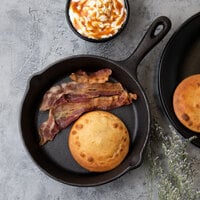
Why Does The Porosity of Cast Iron Matter?
Cast iron is a porous material, meaning it will slowly absorb oil and other food particles, creating the sought-after non-stick sheen. Because of this, you can use less oil when you cook with a well-seasoned cast iron pan, yet still get the non-stick convenience that you want when cooking foods like eggs and pancakes.

Don't cook acidic foods like tomatoes, vinegar, and wine in cast iron. They react with the metal and can give your dishes a metallic taste.

Cast Iron Heat Retention and Heat Conduction Explained
Thanks to its density, cast iron is one of the best materials at retaining heat. It will keep hot foods, hotter, longer, and it will maintain its heat for quicker recovery between dishes. However, cast iron is not the best conductor of heat. It tends to heat unevenly, creating hot spots in the pan.

Make sure the burner is large enough for the cookware you're using. This will ensure a nice, even heat distribution, since heat conduction isn't on your side when using cast iron. Additionally, make sure you leave enough time for heating the pan properly, before cooking.
Remember: Given proper treatment and time to heat up before use, cast iron holds temperatures extremely well.
Related Resources
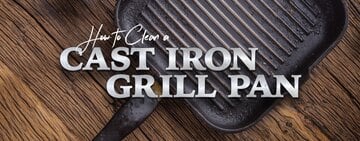
How to Clean a Cast Iron Pan
Whether it's been passed down through generations or just recently purchased, a cast iron grill pan is a vital tool to have in your kitchen. But once service is over, do you know how to properly clean your cast iron grill pan? With the right care, these pans can outlast even your most durable non-stick or stainless steel pans. After cooking with cast iron , follow these steps on how to clean and season a cast iron skillet to ensure your sturdy cast iron stays a staple in your commercial kitchen. Shop All Cast Iron Grill Pans How to Clean a Cast Iron Grill Pan Check out our tutorial for a visual demonstration on cleaning a cast iron grill pan: How Do You Clean a Cast Iron Pan? Below are the best ways to clean a cast-iron pan after cooking: H
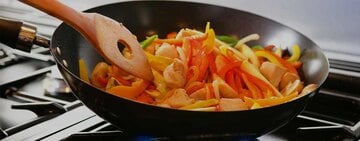
How To Season and Clean a Wok
After choosing the type of wok that works best for you, it's time to determine if your pan needs to be seasoned. Woks that are made of porous metals like cast iron and carbon steel must be seasoned before cooking to prevent rust. This article will provide you with detailed instructions for cleaning, seasoning, and caring for your new cookware. Shop All Woks Use these links to learn more about each aspect of cleaning and seasoning a wok. How to Season a Wok Video How to Season a Wok Why Season a Wok? How to Clean a Wok How to Clean a Wok After Use Best Oil For Wok How to Season a Wok Video If you're looking for a visual guide on how to clean and season a wok, check out our video below. How to Season a Wok Every chef has his or her own favori
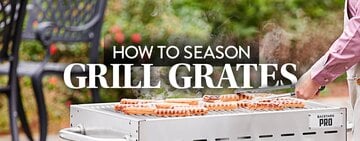
How to Season and Care for Your Grill Grate
Season Your Grill Grate in 4 Simple Steps! Nothing quite says "summer" like the smell of barbecue wafting in the air. But before you fire up the grill, be sure to assess the condition of your commercial outdoor grill . Is food sticking to your grill grate? Is rust starting to form due to high-volume outdoor use? Then it's time to season your grill grate - and we'll tell you how to do it in just 4 simple steps. Whether you're firing burgers at a catered event or grilling kebabs on your poolside patio deck, this guide will ensure that you serve up success at your next barbecue! How to Season and Care for Your Grill Grate Remove grate; preheat grill to medium heat. Wash grate thoroughly using a wire brass grill brush and a decarbonizer and deg
- Topics 1346
- Industrial 55
- Troubleshooting Guides 21
- Restaurant Management 128
- Bar Management 55
- Catering Tips 35
- Bakery Management 42
- Food Trucks & Concessions 49
- Advertising & Marketing 37
- Eco-Friendly Tips 11
- Facility Layout & Design 41
- Coffee Shop Tips 28
- Installation & Maintenance 51
- Janitorial & Pest Control 30
- Safety & Sanitation 88
- Startup Tips 104
- Menu Design 10
- Kitchen & Cooking Tips 81
- Hospitality Management 23
- Pizza & Sandwich Shop Tips 36
- Smallwares 37
- Food Prep 88
- Tabletop Items 17
- Disposables 22
- Calculators & Tools 6
- Consumables 52
- Warewashing & Laundry 18
- Cooking Equipment 90
- Food Storage & Refrigeration 51
- Beverage Equipment 34
- Office Supplies 6
- Resource Type
- In-Depth Articles272
- Buying Guides296
- How-Tos93
- Product Reviews77


